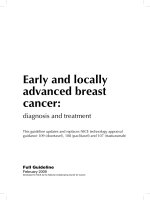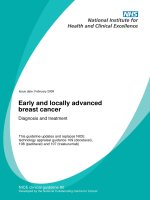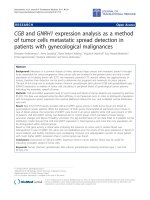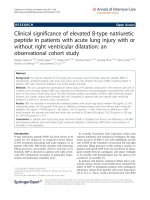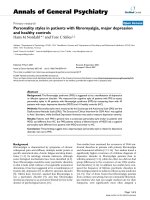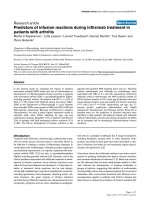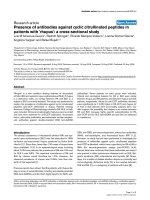Risk factors of PSA progression and overall survival in patients with localized and locally advanced prostate cancer treated with primary androgen deprivation therapy
Bạn đang xem bản rút gọn của tài liệu. Xem và tải ngay bản đầy đủ của tài liệu tại đây (1.7 MB, 9 trang )
Tomioka et al. BMC Cancer (2015) 15:420
DOI 10.1186/s12885-015-1429-0
RESEARCH ARTICLE
Open Access
Risk factors of PSA progression and overall
survival in patients with localized and locally
advanced prostate cancer treated with primary
androgen deprivation therapy
Atsushi Tomioka, Nobumichi Tanaka, Motokiyo Yoshikawa, Makito Miyake, Satoshi Anai, Yoshitomo Chihara,
Eijiro Okajima, Akihide Hirayama, Yoshihiko Hirao and Kiyohide Fujimoto*
Abstract
Background: Primary androgen deprivation therapy (PADT) has played an important role in the treatment of
prostate cancer. We sought to identify factors of PSA progression in our series of patients with localized and locally
advanced prostate cancer treated with PADT.
Methods: Six-hundred forty-nine patients with localized and locally advanced prostate cancer who received PADT
from 1998 to 2005 by Nara Uro-Oncology Research Group were enrolled. Age, T classification, stage, PSA level at
diagnosis, Gleason score, laterality of cancer detected by biopsy and seminal vesicle involvement (SVI) were adopted
as parameters of PSA progression. Cox’s proportional hazards model was used to determine the predictive factors
for PSA progression.
Results: The median follow-up period and the median PSA level at diagnosis were 49 months and 15 ng/mL. The
5-year disease specific survival rate, overall survival rate and PSA progression-free survival (PFS) rate were 97.9 %,
91.9 % and 71.2 %, respectively. The univariate analysis showed that the PSA level at diagnosis, Gleason score,
laterality of cancer detected by biopsy and SVI were independent predictive parameters of PSA-PFS. However, by
multivariate analysis, only laterality of cancer detected by biopsy (unilateral vs. bilateral) was an independent predictive
parameter of PSA-PFS (p = 0.034). The patients were classified into new risk groups base on three factors: PSA level at
diagnosis, Gleason score, and laterality of cancer detected by biopsy. The PSA-PFS rates at 5-years in the low- (none or
one factor), intermediate- (two factors) and high-risk (three factors) groups were 78.2 %, 62.5 % and 46.9 % (p < 0.001),
respectively.
Conclusion: In localized or locally advanced prostate cancer patients who received PADT, laterality of cancer detected
by biopsy was a significant predictor associated with a longer PSA-PFS. Our new risk grouping indicates the usefulness
of PSA-PFS.
Keywords: Localized and locally advanced prostate cancer, Primary androgen deprivation therapy, Risk factors
Background
Androgen deprivation therapy (ADT) has played an important role in the treatment of prostate cancer since it
was first reported by Huggins and Hodges [1]. Initially,
ADT consisted of either surgical castration or estrogen administration. However, these procedures have problems
* Correspondence:
Department of Urology, Nara Medical University, 840 Shijo-cho, Kashihara,
Nara 634-8522, Japan
related to the irreversible nature of castration and the side
effects of estrogen administration on the cardiovascular
system. These problems were resolved by suppression of
the blood testosterone, which could be achieved by administration of a luteinizing hormone-releasing hormone
(LH-RH) agonist, and the cardiovascular side-effects were
reduced by anti-androgen agents. Combined androgen
blockade (CAB) treatment using anti-androgen agents in
© 2015 Tomioka et al.; licensee BioMed Central. This is an Open Access article distributed under the terms of the Creative
Commons Attribution License ( which permits unrestricted use, distribution, and
reproduction in any medium, provided the original work is properly credited. The Creative Commons Public Domain
Dedication waiver ( applies to the data made available in this article,
unless otherwise stated.
Tomioka et al. BMC Cancer (2015) 15:420
combination with castration was developed, and was
shown to facilitate stronger androgen suppression.
Widespread screening for prostate-specific antigen
(PSA) has led to a significant increase in the detection of
early stage, clinically localized prostate cancer. Currently,
treatment of localized prostate cancer remains controversial. In the US it is frowned upon to give ADT for localized disease. The CaPSURE data from the USA
indicated that 44 % of patients underwent radical prostatectomy, 23 % received definitive radiotherapy and 20 %
received primary androgen deprivation therapy (PADT)
[2]. On the other hand, the Japan Prostate Cancer Study
Group showed the corresponding figures were 39.5 %,
23.9 % and 28.0 %, respectively [3] and the figures from
Nara Uro-Oncological Research Group (NUORG) were
40 %, 16 % and 38 %, respectively [4–6]. As background
of the present study, several reasons why Japanese patients with localized and locally advanced prostate cancer hesitate to undergo radical prostatectomy and prefer
to receive PADT are proposed. Firstly, all patients are
completely covered by the public health insurance system in Japan [5]. Secondly, Japanese patients tolerate
hormonal therapy well without severe side effects for a
long time [7, 8]. Thirdly, in those days radiotherapy was
not widespread and doctors at hospitals where modalities for radiation therapy were not available usually
chose PADT if the patients were unwilling to undergo
radical prostatectomy [4, 5]. Fourthly, in those days,
49.9 % of the patients with localized or locally advanced
prostate cancer were considered as the D’Amico highrisk group. 5-year biochemical recurrence-free rate in
the D’Amico high-risk group treated with prostatectomy
estimated 46.3 % [9]. 51 % of the patients with localized
or locally advanced prostate cancer received PADT [4].
Recently, ADT is used as the primary treatment for advanced prostate cancer, and the efficacy of PADT for localized or locally advanced prostate cancer has also been
reported [10, 11]. Mounting data on the efficacy and safety
of ADT has brought about increased use of PADT in patients with localized or locally advanced prostate cancer in
many countries, despite limited evidence to date on the
impact on clinical outcomes [12–14].
We performed a retrospective study of the efficacy of
PADT and identified risk factors for PSA progression in
our series of patients with localized and locally advanced
prostate cancer.
Methods
This study retrospectively evaluated 649 Japanese patients with localized and locally advanced prostate cancer who received PADT following diagnosis by the
NUORG between January 1998 and December 2005.
The diagnosis was based on prostate biopsy. Computed
tomography, bone scans, magnetic resonance imaging
Page 2 of 9
and/or transrectal ultrasonography were used in all
cases. These patients selected PADT for various reasons,
including older age, patient’s preference and comorbidity
such as severe cardiovascular disease or other malignancies, although definitive therapy such as radical prostatectomy or irradiation is the standard treatment for
patients with localized prostate cancer.
Follow-up data were retrieved from hospital medical
records. Patients were followed every month for the first
3 months and every 3 months thereafter. PSA progression was defined as the first day when the PSA was increased for three consecutive times or when clear
clinical radiological evidence of progressive disease was
seen. PSA progression-free survival (PFS) rate was estimated by the Kaplan-Meier method and the log rank
test was used to assess differences between groups: Age
(≤75 vs. 76≤), T classification, stage (B vs. C), PSA level
at diagnosis (<10 ng/mL vs. 10–20 ng/mL vs. 20 ng/
mL≤), Gleason score (6 vs. 7 vs. 8≤), laterality of cancer
detected by biopsy (unilateral vs. bilateral) and seminal
vesicle involvement (SVI; negative vs. positive). Based on
the result of the log rank test, the Cox proportional hazards regression model was performed to analyze independent predictors of PSA progression.
We classified the patients into the modified D’Amico
risk groups [15] and the Japan Cancer of the prostate Risk
Assessment (J-CAPRA) risk groups [16]. The modified
D’Amico risk grouping classifies patients into three risk
groups based on PSA level at diagnosis and Gleason score:
low- (PSA level at diagnosis ≤10 ng/mL and Gleason
score ≤ 6; 112 patients), intermediate- (10 ng/mL < PSA
level at diagnosis ≤20 ng/mL and/or Gleason score 7; 203
patients), and high- risk (PSA level at diagnosis >20 ng/
mL or 8 ≤ Gleason score; 334 patients). In J-CAPRA risk
grouping, patients were assigned 1 point for Gleason score
7 and 2 points for Gleason score 8 to 10; 1 point for PSA
level at diagnosis 20 to 100 ng/mL, 2 points for PSA 100
to 500 ng/mL, and 3 points for PSA higher than 500 ng/
mL; 1 point for stage T2c or T3a, 2 points for T3b, and 3
points for T4. Points for each variable are summed to
yield a total score with a range of 0 to 12. The J-CAPRA
score was also categorized to identify three groups at low(0 to 2 points; 459 patients), intermediate- (3 to 7 points;
190 patients) and high- (8 to 12 points; 0 patient) risk of
recurrence.
Statistical analysis was performed SPSS 11.0 J (SPSS
Inc., Chicago, Illinois) and p < 0.05 was considered statistically significant. The product limit method of KaplanMeier was used to assess survival. The log-rank method
was used to assess differences between groups. The Cox
proportional hazards model was performed to analyze
independent predictors of PSA-PFS. Only the variables
that were found to be significant in the univariate analyses (p < 0.05) were entered into the multivariate
Tomioka et al. BMC Cancer (2015) 15:420
Page 3 of 9
analysis to determine the most significant factor for
predicting disease outcome.
The Medical Ethics Committee of Nara Medical University approved this retrospective study.
Results
The median age, the median follow-up period and the median PSA level at diagnosis were 77 years (mean: 76.5;
range: 53–95), 49 months (mean: 52.0; range: 12–143) and
15 ng/mL (mean: 28.9; range: 1.4 – 200), respectively
(Table 1). The number of patient cores was varied and the
median was 7 (mean: 8.03; range: 2–25). The 5-year overall survival rate was 91.9 % and 7.6 % of patients (49 patients) died during follow-up. The 5-year disease specific
survival rate was 97.9 % and 1.2 % of patients (8 patients)
died of prostate cancer (Fig. 1). The 5-year PSA-PFS rates
were 71.2 % (Fig. 2). A total of 566 patients (87.2 %), 70
patients (10.8 %) and 13 patients (2.0 %) were treated with
CAB, LH-RH agonist alone and anti-androgen alone, respectively. Significant differences in a log-rank test of
PSA-PFS rates was observed between CAB and LH-RH
agonist alone (p = 0.015) (Fig. 3).
Table 2 shows the results of analysis for PSA-PFS by a
log-rank test. T classification (T1c vs.T2c; p = 0.036, T1c
vs.T3b; p = 0.028, T2ab vs.T2c; p = 0.001, T2ab vs. T3b;
p = 0.003), PSA level at diagnosis (10–20 ng/mL vs.
20 ng/mL≤; p = 0.002, <10 ng/mL vs. 20 ng/mL≤; p <
0.001), Gleason score (7 vs. 8≤; p = 0.028, 6 vs. 8≤; p =
0.004), laterality of cancer detected by biopsy (unilateral
vs. bilateral; p < 0.001) and SVI (negative vs. positive;
p = 0.030) were significantly associated with PSA-PFS.
We used a Cox’s proportional hazards model to determine the predictive parameter of PSA progression. Based
on the result of the log-rank test, age (≤75 vs. 76≤), stage
(B vs. C), PSA level at diagnosis (<20 ng/mL vs. 20 ng/
mL≤), Gleason score (≤7 vs. 8≤), laterality of cancer detected by biopsy (unilateral vs. bilateral) and SVI (negative vs. positive) were adopted as clinicopathological
parameters of PSA progression and T classification was
excluded as a parameter in grouping the patients, because it was difficult to distinguish the cutoff point. PSA
level at diagnosis, Gleason score, laterality of cancer detected by biopsy and SVI were the significant factors
for a longer PSA-PFS. But, by multivariate analysis,
only laterality of cancer detected by biopsy was an independent predictive parameter of PSA-PFS (Hazard
Table 1 Characteristic of patients
Median
Mean
Range
Age (years)
77
76.5
53-95
Follow-up period (months)
49
52.0
12-143
PSA level at diagnosis (ng/mL)
15
28.9
1.4-200
ratio: 1.523, p = 0.034, 95 % confidence interval: 1.0332.245) (Table 3).
PSA-PFS rates at 5 years in low-, intermediate- and
high-risk groups by the modified D’Amico risk grouping
were 80.7 %, 78.5 % and 63.8 % (Fig. 4). A significant difference in PSA-PFS rate was observed between the
intermediate- and high-risk groups (p = 0.003), but there
was no difference between the low- and intermediaterisk groups (p = 0.493), as reported by Ueno et al. [14].
In the J-CAPRA risk grouping, PSA-PFS rates at 5 years
in the low- and intermediate- risk groups were 78.3 %
and 49.9 % (p < 0.001) (Fig. 5).
We classified the patients into our new risk groups
based on three factors: PSA level at diagnosis (<20 ng/mL
vs. 20 ng/mL≤), Gleason score (≤7 vs. 8≤) and laterality of
cancer detected by biopsy (unilateral vs. bilateral). The
low- (431 patients), intermediate- (153 patients) and highrisk (65 patients) groups included none or one, two and
three factors, respectively. PSA-PFS rates at 5 years in the
respective risk groups were 78.2 %, 62.5 % and 46.9 %, respectively, and a significant difference in the PSA-PFS rate
was observed between groups by the log-rank test (p <
0.001) (Fig. 6). The Cox proportional hazards model
showed the same result as the log-rank test (Table 4).
Discussion
Although PADT has been widely used for the treatment
of prostate cancer at any early disease stage, there is not
much information regarding the clinical outcomes associated with clinically localized and locally advanced prostate
cancer treated by PADT. According to some reports, a
survival advantage of CAB over castration monotherapy
has been indicated [10, 16, 17]. Thus, the focus of the
present study was placed on CAB rather than castration
monotherapy as PADT to evaluate its efficacy in terms of
long-term disease control of clinically localized and locally
advanced prostate cancer.
At the present time, the younger patients with localized prostate cancer and locally advanced prostate cancer without complications have a tendency to select the
radical treatment such as prostatectomy. But, in those
days, the use of PADT was still common in patients with
localized prostate cancer and locally advanced prostate
cancer in Japan [4, 6]. In many cases, the patients might
select PADT by older age or some complications.
In this study, the PSA-PFS (71.2 % at 5 years) was
similar to other previous reports [10, 16–18]. These results were worse than other treatment modalities such
as prostatectomy and radiotherapy. If the PSA progression was defined as the day when the PSA at least
4 weeks later was 25 % increase over nadir with more
than 2 ng/mL, the PSA-PFS might be better. The disease
specific survival rate was very high (97.9 % at 5 years)
even though 23.3 % of patients had stage C, suggesting a
Tomioka et al. BMC Cancer (2015) 15:420
Page 4 of 9
Kaplan-Meier plots showing the incidence of disease specific and overall
survival rate
Disease specific and overall survival rates
1.0
.8
.6
5y
.4
Disease specific 97.9%
91.9%
Overall
.2
0.0
0
20
40
60
80
100
Disease specific
649
596
219
38
Overall
649
596
219
38
Number at risk
120
140
160
Months
Fig. 1 Kaplan-Meier plots showing the incidence of disease specific and overall survival rate
possible cure of localized and locally advanced prostate
cancer by PADT. Egawa et al. reported that PADT was
as effective as radical prostatectomy with regard to
disease-specific survival rate in localized prostate cancer
[19] and Akaza et al. demonstrated no difference in
overall survival in patients with localized prostate cancer
treated with PADT and men of the same age among the
general population, suggesting that there is no increase
in the mortality of men treated with PADT [7].
Although prospective data defining the risks and benefits are lacking, clinical practice trends show an increased use of ADT as monotherapy. Date from the
results of the CAPSURE™ survey shows an increase in
the incidence of patients treated with PADT from 1989
to 2000, during which time the percent assigned to the
low-, intermediate- and high-risk groups increased from
4.6 % to 14.2 %, 8.9 % to 19.7 % and 32.8 % to 48.2 %, respectively [20].
On the other hand, there is growing evidence that
ADT is associated with an increased risk of various comorbidities including ischemic heart disease, metabolic
syndrome, glucose intolerance, and a decrease in bone
mineral density [21–24]. As a result, patients who received PADT have worse overall survival compared with
Fig. 2 Kaplan-Meier plot showing the incidence of PSA progression-free survival rate
Tomioka et al. BMC Cancer (2015) 15:420
Page 5 of 9
Fig. 3 Kaplan-Meier plots showing the incidence of PSA progression-free survival rate classified by treatment
Table 2 Results of analysis of PSA-PFS by log-rank test
Total
Age
T classification
No. of patients
No. of PSA progression
5 year PSA-PFS rate
649
161
71.2 %
≤75
265
66
73.9 %
76≤
384
95
69.0 %
T1c
189
42
71.8 %
T2ab
205
37
78.9 %
T2c
104
36
65.2 %
T3a
103
28
70.1 %
T3b
48
18
54.0 %
Stage
B
498
115
73.2 %
C
151
46
64.9 %
PSA level at diagnosis
<10
197
31
83.2 %
Gleason score
10-20
195
42
75.2 %
20≤
257
88
59.4 %
6
288
60
76.2 %
7
196
43
72.0 %
8≤
165
58
61.8 %
Laterality of cancer detected by biopsy
Unilateral
365
66
77.2 %
Bilateral
284
95
63.8 %
SVI
Negative
601
143
72.7 %
Positive
48
18
54.0 %
PSA-PFS: PSA progression-free survival
SVI: seminal vesicle involvement
*
: T1c vs. T2c; p = 0.036. T1c vs. T3b; p = 0.028. T2ab vs. T2c; p = 0.001. T2ab vs. T3b; p = 0.003. others; p > 0.05
**: <10 vs. 10–20; p = 0.192. 10–20 vs. 20≤; p = 0.002. <10 vs. 20≤; p < 0.001
***: 6 vs. 7, p = 0.310. 7 vs. 8≤; p = 0.028. 6 vs. 8≤; p = 0.004
log-Rank
0.230
*
0.155
**
***
<0.001
0.030
Tomioka et al. BMC Cancer (2015) 15:420
Page 6 of 9
Table 3 Results of analysis of PSA-PFS by Cox proportional hazards model
Univariate
Hazard-ratio
Age
≤75
1
76≤
1.213
Stage
B
1
C
1.283
PSA level at diagnosis
<20
1
20≤
2.048
Gleason score
≤7
1
8≤
1.734
Laterality of cancer detected by biopsy
unilateral
1
bilateral
2.102
SVI
Negative
1
Positive
1.71
p
Multivariate
95 % CI
0.232
0.884- 1.666
0.157
0.908-1.813
Hazard-ratio
p
95 % CI
1
<0.001
1.500-2.797
1.613
0.071
0.959-2.711
0.064
0.979-2.107
0.034
1.033-2.245
0.753
0.582-2.113
1
0.001
1.256-2.393
1.436
1
<0.001
1.533- 2.883
1.523
1
0.032
1.046- 2.793
1.109
PSA-PFS: PSA progression-free survival
95 % CI: 95 % confidence interval
SVI: seminal vesicle involvement
conservative management [25, 26]. In contrast, several
reports have also shown no significant increase in cardiovascular mortality with ADT in men with prostate
cancer [27–29].
Several parameters were isolated as predictors of PSA
progression. Nadir PSA level and the percentage of
positive biopsy cores remained as independent prognostic factors on multivariate analysis [18]. Younger patients
(<70 years) and those with 6 ≤ Gleason score were at a
higher risk of treatment failure [30]. Ueno et al. reported
that PSA ≤20 ng/mL, Gleason score ≤7, and time to
nadir PSA ≤6 months showed a good response to PADT
Fig. 4 Kaplan-Meier plots showing the incidence of PSA progression-free survival rate classified by D’Amico risk grouping
Tomioka et al. BMC Cancer (2015) 15:420
Page 7 of 9
Fig. 5 Kaplan-Meier plots showing the incidence of PSA progression-free survival rate classified by J-CAPRA risk grouping
[17]. In this study, there was no difference between Gleason
score of 6 vs. 7 ≤ (p = 0.310), and we adopted a Gleason score
≤7 vs. 8 ≤ as a parameter of PSA progression in Cox’s proportional hazards model. We found that PSA level at diagnosis, Gleason score, laterality of cancer detected by biopsy and
SVI were significant factors for a longer PSA-PFS, except for
age and stage by univariate analysis. Then, by multivariate
analysis, only laterality of the cancer detected by biopsy was
an independent predictive parameter of PSA-PFS.
Firstly, we classified the patients using our four new
risk groups: no, one, two and three factors. No significance difference was shown between the no factor
Fig. 6 Kaplan-Meier plots showing the incidence of PSA progression-free survival rate classified by our new risk grouping
Tomioka et al. BMC Cancer (2015) 15:420
Page 8 of 9
Table 4 The Cox proportional hazards model of PSA-PFS
Hazard-ratio
D’Amico
J-CAPRA
Our new grouping
p
95 % CI
Low
1
Intermediate
1.212
0.493
0.693-2.119
High
2.116
0.003
1.289-3.492
<0.001
1.942-3.542
Low
1
Intermediate
2.623
Low
1
Intermediate
1.936
<0.001
1.350-2.778
High
3.408
<0.001
2.269-5.117
PSA-PFS: PSA progression-free survival
95 % CI: 95 % confidence interval
(34.2 %, 222 of 649 patients) and one factor (32.2 %,
209 of 649 patients) (p = 0.091). Therefore we combined the no and one factor into the low-risk group.
Our low-risk factor patients accounted for two-thirds of
the T1c-T3b patients. For patients showing a good response to ADT, ADT showed an excellent effect in this
study. This effect may be explained by the observation
that resected specimens after neoadjuvant ADT were
sometimes completely apoptotic. Kitagawa et al. analyzed
the histological effects of ADT in specimens from patients
treated with radical prostatectomy after neoadjuvant ADT
[31]. They reported that histologically cured or nearly
cured patients accounted for more than 40 % of the total
number. In addition, the recurrence-free survival rate of
patients with complete apoptosis was 100 %. These results
supported our observation that some cases of localized
prostate cancer could be cured by ADT alone. Schulman
et al. also performed neoadjuvant ADT for 3 months before radical prostatectomy in patients with localized prostate cancer, and good histopathological effects [32].
In the modified D’Amico risk grouping, a significant
difference in PSA-PFS rate was observed between the
intermediate- and high-risk groups, but there was no
difference between the low- and intermediate-risk
groups. The J-CAPRA risk grouping included also
metastatic cancer patients in addition to localized and
locally advanced prostate cancer. Our new risk groups
included only localized and locally advanced prostate
cancer patients and a significant difference of PSA-PFS
rate was observed between all groups. Our new risk
grouping indicates the usefulness for localized and locally advanced prostate cancer patients treated with
PADT.
There are several limitations to the current study.
Firstly, there may be interobserver variation of the Gleason score between general pathologists and uropathologists. Secondly, the current study is retrospective and
results should be interpreted accordingly.
Conclusions
Unilateral positive biopsy was a significant predictor associated with a longer PSA-PFS in localized or locally advanced
prostate cancer patients who received PADT. Our new risk
groups according to the three factors of PSA level at diagnosis, Gleason score and laterality of cancer detected by biopsy indicate the usefulness for PSA-PFS. The efficacy and
toxicity of ADT for localized or locally advanced prostate
cancer requires further study before it can be recommended as the primary treatment. In the future, a prospective randomized study or comparative study of QOL
or medical cost compared with other treatments will be
necessary to establish PADT as a recommended treatment
for early prostate cancer. Our results provide potentially
clinical useful predictive tools for physicians and patients
contemplating PADT for localized or locally advanced
prostate cancer as well as the outcomes necessary to design prospective studies of the treatment strategy.
Abbreviations
ADT: Androgen deprivation therapy; LH-RH: Luteinizing hormone-releasing
hormone; CAB: Combined androgen blockade; PSA: Prostate specific antigen;
PADT: Primary androgen deprivation therapy; NUORG: Nara Uro-Oncological
Research Group; PFS: Progression-free survival; SVI: Seminal vesicle
involvement.
Competing interests
The authors declare that they have no competing interests.
Authors’ contributions
AT contributed to analysis and interpretation of data and was involved in
drafting the manuscript. TN contributed to conception and helped to draft
the manuscript. MY, MM, SA and YC contributed to acquisition of data.
EO and AH contributed to acquisition of data and helped to draft the
manuscript. YH and KF conceived and supervised the study, helped to
draft the manuscript and was involved in revising it critically for important
intellectual content. All authors read and approved the final manuscript.
Acknowledgments
The authors acknowledge the efforts of Nara Uro-Oncology Research Group
(Nara Medical University Hospital, Nara Prefecture General Medical Center,
Nara Prefecture Western Medical Hospital, Nara City Hospital, Yamato Takada
Municipal Hospital, Uda City Hospital, Saiseikai Nara Hospital, Saiseikai Chuwa
Hospital, Takanohara Central Hospital, Takai Hospital, Hirao Hospital, Nara
Yukoukai Hospital, Hanna Central Hospital, Hoshigaoka Medical Center, Osaka
Gyoumeikan Hospital, Osaka Kaisei Hospital, Tane General Hospital, Okanami
General Hospital and Matsusaka Chuo General Hospital) that registered the
patient’s data.
Received: 4 October 2014 Accepted: 11 May 2015
References
1. Huggins C, Hodges CV. Studies on prostatic cancer. I. The effect of
castration, of estrogen and androgen injection on serum phosphatases in
metastatic carcinoma of the prostate. CA Cancer J Clin. 1972;22(4):232–40.
2. Cooperberg MR, Lubeck DP, Penson DF, Mehta SS, Carroll PR, Kane CJ.
Sociodemographic and clinical risk characteristics of patients with prostate
cancer within the Veterans Affairs health care system: data from CaPSURE.
J Urol. 2003;170(3):905–8.
3. Onozawa M, Hinotsu S, Tsukamoto T, Oya M, Ogawa O, Kitamura T, et al.
Recent trends in the initial therapy for newly diagnosed prostate cancer in
Japan. Jpn J Clin Oncol. 2014;44(10):969–81.
4. Tanaka N, Fujimoto K, Hirayama A, Yoneda T, Yoshida K, Hirao Y. Trends of
the primary therapy for patients with prostate cancer in Nara uro-
Tomioka et al. BMC Cancer (2015) 15:420
5.
6.
7.
8.
9.
10.
11.
12.
13.
14.
15.
16.
17.
18.
19.
20.
21.
22.
23.
24.
25.
oncological research group (NUORG): a comparison between the CaPSURE
data and the NUORG data. Jpn J Clin Oncol. 2010;40(6):588–92.
Tanaka N, Fujimoto K, Hirayama A, Samma S, Momose H, Kaneko Y, et al.
The primary therapy chosen for patients with localzed prostate cancer
between the university hospital and its affiliated hospital in Nara UroOncological Research Group redistration. BMC Urol. 2011;11:6.
Tanaka N, Hirayama A, Yoneda T, Yoshida K, Konishi N, Fujimoto K. Trends of
risk classification and primary therapy for Japanese patients with prostate
cancer in Nara uro-oncological research group (NUORG): a comparison
between 2004–2006 and 2007–2009. BMC Cancer. 2013;13:588.
Akaza H, Homma Y, Usami M, Hirao Y, Tsushima T, Okada K, et al. Efficacy of
primary hormone therapy for localized or locally advanced prostate cancer:
results of a 10-year follow-up. BJU Int. 2006;98(3):573–9.
Akaza H. Future prospects for luteinizing hormone-releasing hormone
analogues in prostate cancer treatment. Pharmacology. 2010;85(2):110–20.
Tanaka N, Fujimoto K, Hirayama A, Torimoto K, Okajima E, Tanaka M, et al.
Risk-strarified survival rates and predictors of biochemical recurrence after
radical prostatectomy in Nara, Japan, cohort study. Int J Clin Oncol.
2011;16(5):553–9.
Akaza H, Homma Y, Okada K, Yokoyama M, Usami M, Hirao Y, et al.
A prospective and randomized study of primary hormonal therapy for patients
with localized or locally advanced prostate cancer unsuitable for radical
prostatectomy: results of the 5-year follow-up. BJU Int. 2003;91(1):33–6.
Labrie F, Candas B, Gomez JL, Cusan L. Can combined androgen blockade
provide long-term control or possible cure of localized prostate cancer?
Urology. 2002;60(1):115–9.
Cooperberg MR, Grossfeld GD, Lubeck DP, Carroll PR. National practice
patterns and time trends in androgen ablation for localized prostate cancer.
J Natl Cancer Inst. 2003;95(13):981–9.
Shahinian VB, Kuo YF, Freeman JL, Orihuela E, Goodwin JS. Increasing use of
gonadotropin-releasing hormone agonists for the treatment of localized
prostate carcinoma. Cancer. 2005;103(8):1615–24.
Weight CJ, Klein EA, Jones JS. Androgen deprivation falls as orchiectomy
rates rise after changes in reimbursement in the U.S. Medicare population.
Cancer. 2008;112(10):2195–201.
D'Amico AV, Whittington R, Malkowicz SB, Schultz D, Blank K, Broderick GA,
et al. Biochemical outcome after radical prostatectomy, external beam
radiation therapy, or interstitial radiation therapy for clinically localized
prostate cancer. JAMA. 1998;280(11):969–74.
Hinotsu S, Akaza H, Usami M, Ogawa O, Kagawa S, Kitamura T, et al. Current
status of endocrine therapy for prostate cancer in Japan analysis of primary
androgen deprivation therapy on the basis of data collected by J-CaP. Jpn J
Clin Oncol. 2007;37(10):775–81.
Ueno S, Namiki M, Fukagai T, Ehara H, Usami M, Akaza H. Efficacy of primary
hormonal therapy for patients with localized and locally advanced prostate
cancer: a retrospective multicenter study. Int J Urol. 2006;13(12):1494–500.
Kobayashi M, Nukui A, Suzuki K, Kurokawa S, Morita T. Clinical efficacy of
primary combined androgen blockade for Japanese men with clinically
localized prostate cancer unsuitable for local definitive treatment: a single
institution experience. Int J Clin Oncol. 2011;16(6):630-6.
Egawa M, Misaki T, Imao T, Yokoyama O, Fuse H, Suzuki K, et al.
Retrospective study on stage B prostate cancer in the Hokuriku District.
Japan Int J Urol. 2004;11(5):304–9.
Cancer Registrarion Committee of Japan Urological Association.
Clinicopathological statistics on registered prostate cancer patients in Japan:
2000 report from the Japanese Urological Association. Int J Urol. 2005;12(1):46–61.
Braga-Basaria M, Dobs AS, Muller DC, Carducci MA, John M, Egan J, et al.
Metabolic syndrome in men with prostate cancer undergoing long-term
androgen-deprivation therapy. J Clin Oncol. 2006;24(24):3979–83.
D'Amico AV, Denham JW, Crook J, Chen MH, Goldhaber SZ, Lamb DS, et al.
Influence of androgen suppression therapy for prostate cancer on the
frequency and timing of fatal myocardial infarctions. J Clin Oncol.
2007;25(17):2420–5.
Keating NL, O'Malley AJ, Freedland SJ, Smith MR. Diabetes and
cardiovascular disease during androgen deprivation therapy: observational
study of veterans with prostate cancer. J Natl Cancer Inst. 2010;102(1):39–46.
Shahinian VB, Kuo YF, Freeman JL, Goodwin JS. Risk of fracture after
androgen deprivation for prostate cancer. N Engl J Med. 2005;352(2):154–64.
Lu-Yao GL, Albertsen PC, Moore DF, Shih W, Lin Y, DiPaola RS, et al. Survival
following primary androgen deprivation therapy among men with localized
prostate cancer. JAMA. 2008;300(2):173–81.
Page 9 of 9
26. Wong YN, Freedland S, Egleston B, Hudes G, Schwartz JS, Armstrong K.
Role of androgen deprivation therapy for node-positive prostate cancer.
J Clin Oncol. 2009;27(1):100–5.
27. Efstathiou JA, Bae K, Shipley WU, Hanks GE, Pilepich MV, Sandler HM, et al.
Cardiovascular mortality after androgen deprivation therapy for locally
advanced prostate cancer: RTOG 85–31. J Clin Oncol. 2009;27(1):92–9.
28. Roach 3rd M, Bae K, Speight J, Wolkov HB, Rubin P, Lee RJ, et al. Short-term
neoadjuvant androgen deprivation therapy and external-beam radiotherapy
for locally advanced prostate cancer: long-term results of RTOG 8610. J Clin
Oncol. 2008;26(4):585–91.
29. Studer UE, Whelan P, Albrecht W, Casselman J, de Reijke T, Hauri D, et al.
Immediate or deferred androgen deprivation for patients with prostate
cancer not suitable for local treatment with curative intent: European
Organisation for Research and Treatment of Cancer (EORTC) Trial 30891.
J Clin Oncol. 2006;24(12):1868–76.
30. Janoff DM, Peterson C, Mongoue-Tchokote S, Peters L, Beer TM, Wersinger
EM, et al. Clinical outcomes of androgen deprivation as the sole therapy for
localized and locally advanced prostate cancer. BJU Int. 2005;96(4):503–7.
31. Kitagawa Y, Koshida K, Mizokami A, Komatsu K, Nakashima S, Misaki T, et al.
Pathological effects of neoadjuvant hormonal therapy help predict
progression of prostate cancer after radical prostatectomy. Int J Urol.
2003;10(7):377–82.
32. Schulman CC, Debruyne FM, Forster G, Selvaggi FP, Zlotta AR, Witjes WP.
4-Year follow-up results of a European prospective randomized study on
neoadjuvant hormonal therapy prior to radical prostatectomy in T2-3N0M0
prostate cancer. European Study Group on Neoadjuvant Treatment of
Prostate Cancer. Eur Urol. 2000;38(6):706–13.
Submit your next manuscript to BioMed Central
and take full advantage of:
• Convenient online submission
• Thorough peer review
• No space constraints or color figure charges
• Immediate publication on acceptance
• Inclusion in PubMed, CAS, Scopus and Google Scholar
• Research which is freely available for redistribution
Submit your manuscript at
www.biomedcentral.com/submit

